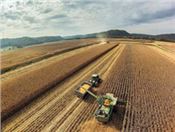UK Ag Economist Offers Reminders For Working Within Tight Budgets

Photo courtesy of Matt Barton, UK Agricultural Communications
PRINCETON, KY.
Kentucky grain producers know profit margins have been tight in the past year. The current futures market is indicating profits will be slim for another year. Todd Davis, agricultural economist with the University of Kentucky, offers growers some important reminders and information for navigating through this challenging time.
“It’s important for producers to not be ‘penny wise and pound foolish,’” said Davis, grain marketing specialist in the UK College of Agriculture, Food and Environment. “They should economize when possible but not in a way that sacrifices their yields.”
While producers cannot control the market, they can control their input costs to a certain extent. Soil testing their fields and applying fertilizers based on university recommendations helps producers know their crops are getting the nutrients they need to reach their maximum yield potential. It is also a way to ensure they do not apply too much fertilizer to the ground, which is expensive and can negatively affect the environment.
Producers can keep overhead costs lower when it comes to farm equipment. They should evaluate and compare the full costs of buying or replacing tractors and other equipment. They can also make sure new equipment purchases match the size of their operation.
Since grain prices have been lower for the past three growing seasons compared to 2010-2014, producers may be able to renegotiate their cash rental rates with property owners to reflect lower profit potential.
Producers need to know their per-bushel costs and keep up-to-date on the markets to ensure they do not miss a potential profitable situation.
“The market may provide one or two opportunities prior to harvest to contract bushels at profitable levels,” Davis said. “Managers need to know their costs to take advantage of these opportunities.” ∆